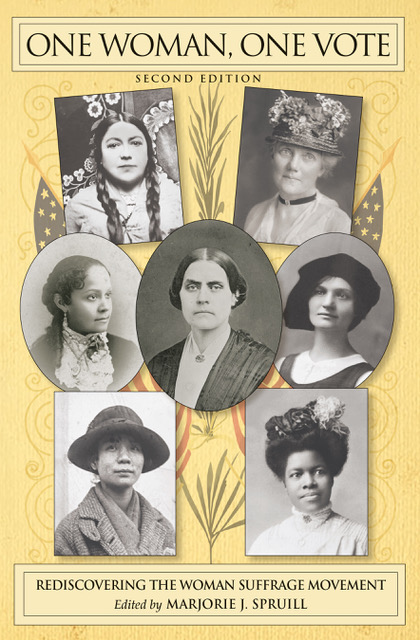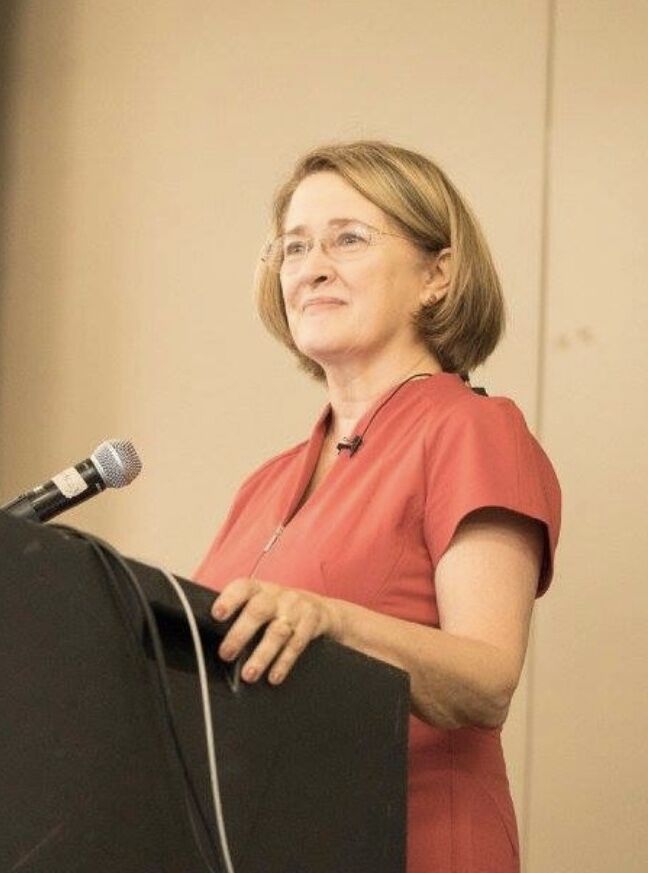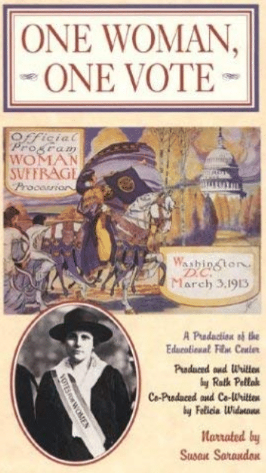Second Edition
One Woman, One Vote: Rediscovering the Woman Suffrage Movement
Marjorie J. Spruill

Pub Date: July 2021
Paperback Original ISBN 978-0939165-76-6
566 pages, $29.00
Includes Historic Photos, Illustrations, Appendixes, Index
Library Edition
ISBN 978-0939165-78-0 566 pages, $42.00
E-Book 978-0939165-77-3 Price varies on Internet venues
Definitive writings by leading historians that cover the full scope of the woman suffrage movement in the United States. This revised and expanded edition offers new material on the international context, race, and regional issues that affected the suffrage movement and the struggles many women faced trying to vote after ratification of the Nineteenth Amendment in 1920 that guaranteed them that right. The editor, Marjorie J. Spruill, is a leading authority in women’s and southern history, and has authored numerous books and essays.
The second edition is an enhanced version of One Woman, One Vote, the companion book to the PBS American Experience documentary by the same name, first published in 1995, which has continued to be the most comprehensive collection of writings on the woman suffrage movement in the United States. On the one hundredth anniversary of the passage of the Nineteenth Amendment, this new edition with twenty-two essays focuses on different aspects of the movement. They are presented in roughly chronological order and together tell the fascinating story of woman suffrage from the failure of the Constitution to enfranchise women to the political engagement of women after 1920. Through their engaging essays, the authors, scholars in the fields of History, American Studies, Political Science, and Sociology, help readers “rediscover” the suffrage movement in all its diversity and complexity, offering intriguing and sometimes contradictory interpretations.
Leading historians explain how the suffrage movement—from its beginning in 1848 to its conclusion in 1920—changed over time in response to changes in American society and politics. Readers are introduced to several generations of suffrage leaders and learn of the supportive relationships as well as tensions that developed among them. They learn of the growing diversity of those fighting for woman suffrage in terms of region, religion, race, class, ethnicity, and even attitude—that the suffrage story included both a record of harmony and cooperation, and of discrimination and betrayal. We also learn that for many women of color the suffrage movement did not end in 1920 but continued—and continues today.
New material in the Second Edition adds further diversity to the book. This includes an in-depth piece on the international history of the U.S. Suffrage Movement by Katherine M. Marino, an assistant professor of history at UCLA. Her essay looks at international influences on the U.S. fight for woman suffrage and how women worldwide collaborated across national borders—many of them women of color fighting for the right to vote as a global goal. Marino’s research reaches back to the American Revolution, the French and Haitian Revolutions, and the Mexican and Russian Revolutions as sources of inspiration for woman suffrage in the U.S.
In addition, Spruill has written a new piece for the second edition, “Bringing In the South: Southern Ladies, White Supremacy, and State’s Rights in the Fight for Woman Suffrage.” She describes the long and often frustrating campaign beginning in the 1890s by northern and southern suffragists to build support for woman suffrage in a decidedly inhospitable climate—an effort shaped by widespread ideas about white supremacy and state’s rights among white Southerners who viewed the movement as an unwelcome offshoot of the antislavery movement that had “no place in the sunny South.”
New material also includes additional appendices illustrating international progress of woman suffrage, dates of state ratification of the Nineteenth Amendment, and the expansion of voting rights in the U.S. after 1920. The book is richly illustrated and contains an extensive index
Above all, the essays in this book illustrate well that the vote was not “given” to women when the Nineteenth Amendment was ratified in 1920: generations of suffragists labored long and hard to win the right to vote in the United States.
Praise
Suffragists were the voting rights activists of their day. This revised and expanded edition of One Woman, One Vote tells the story of that hard-fought victory, warts and all. At a moment when questions of gender, race, and citizenship are center stage once again, the history of the women's suffrage movement remains timely and relevant -- and a really good read. A timely expansion of Marjorie Spruill’s seminal anthology on the long, complex struggle for woman suffrage that continues the story of women and the vote forward from 1920 through the voting rights struggles of today. This new edition is a welcome contribution and update to the lessons from our nation’s history that we continue to examine with fresh eyes. —Lori Ann Terjesen, Director of Education, National Women’s History Museum One Woman, One Vote has been indispensable to me as I've worked to learn so much of the history that I'd not been taught about the nation and its centuries-long struggle toward full enfranchisement.
—Susan Ware, Author of Why They Marched: Untold Stories of the Women Who Fought for the Right to Vote. Honorary Women’s Suffrage Centennial Historian at the Schlesinger Library on the History of Women in America, Harvard University
Marjorie Spruill's seminal anthology sits near the desk—within easy reach—of every scholar and student of the American woman suffrage movement. Few volumes capture the movement so vividly, from so many vantage points, illuminating the complexity and contradictions of this major epoch of our history. This new edition is a welcome gift to a new generation of readers who will find it both a fascinating read and a valuable resource.
—Elaine Weiss, Author of The Woman’s Hour: The Great Fight to Win the Vote
The first edition of One Woman, One Vote became the center pole in our suffrage-movement-history tent. This revised and expanded edition of a classic book is just what we need to understand the connection between the movement that brought us voting rights for women in 1920 and our own turbulent time a century later. A very important book and so useful.
—Kathryn Kish Sklar, Author of Florence Kelley and the Nation's Work: The Rise of Women's Political Culture, 1830--1900
Reviews
…“I had been taught very little in school—shockingly little—about the lengthy, complex, fraught movement for women’s suffrage in this country,” Rebecca Traister wrote in a 2018 article for The Cut, naming six books that inspired her then-new title Good and Mad: The Revolutionary Power of Women’s Anger. “And I often find it strange how few comprehensive texts there are about it.” An exception, Traister wrote, is One Woman, One Vote, a 1995 essay collection edited by Marjorie J. Spruill that NewSage Press published as a companion to a PBS documentary of the same name. The publisher is releasing a revised and expanded second edition in spring 2020. “It tells the overall story, from why women didn’t have the vote, and why a suffrage movement was necessary in the first place,” Spruill says, “all the way through to ‘what difference did it make?’ ” The focus, she says, is not just on the big moments but on incremental change, as women of all backgrounds strategized “how to get men to agree that women should have the vote.” Spruill, a professor emerita of history at the University of South Carolina, has concentrated her research on the South, where, she says, “the suffrage movement had the hardest time, the most obstacles, and least success.” She adds that she values the criticism about racism in the ranks, in the leadership, and in some of the strategies suffragists used in pursuit of the vote. “People are right to deplore the fact that there was so much prejudice against African-Americans getting voting rights,” she says, adding that those focused on national suffrage were “between a rock and a hard place,” fighting to get the amendment through Congress and the Jim Crow South.
From Publishers Weekly article Sept 9, 2019, Battle for the Ballot: Women’s Suffrage Centennial
Reviews of the First Edition of One Woman One Vote
The fight for woman suffrage got under way in 1848 at Seneca Falls, New York, but it took another 72 years to win the right to vote with ratification of the 19th Amendment. To celebrate the 75th anniversary of that event, Spruill, an associate professor of history at the Univ. of Southern Mississippi, has gathered 19 thoughtful essays to tell the story of the women and the strategies that won the vote, put in context by her particularly cogent introduction. Linda K. Kerber examines the Constitution's implicit exclusion of women, explaining why suffragists saw the need for a constitutional amendment. Alice S. Rossi's classic essay "A Feminist Friendship" enlivens the 51-year link between Elizabeth Cady Stanton and Susan B. Anthony. Andrea Moore Kerr looks at a splinter group of suffragists who actively campaigned to prevent newly freed black men from getting the vote before women -- particularly ironic for a movement that had its roots in the abolition movement -- while Rosalyn Terborg-Penn surveys the contributions of African American women. Beverly Beeton details progress in the West, beginning with Wyoming's enfranchisement of women in 1869. And "Armageddon in Tennessee" by Anastatia Sims relates the drama that unfolded when the amendment passed the Tennessee legislature by a single vote cast by a 24-year-old whose mother had adjured him to "be a good boy" and vote for suffrage. Photos not seen by PW. Copyright 1995 Reed Business Information, Inc.
Publishers Weekly
Composed of 19 well-written, scholarly essays selected and introduced by historian [Marjorie Spruill] Wheeler, this work is the companion piece to a PBS special commemorating the 75th anniversary of the ratification of the 19th Amendment to the Constitution. It analyzes both positive and negative aspects of the long, complex struggle for suffrage. The writers emphasize the economic, racial, and cultural divisions that split the movement repeatedly. While extolling the courage of Susan B. Anthony, the pragmatism of Carrie Catt and Jane Addams, the militancy of Alice Paul, and the working-class sensibilities of Harriet Stanton Blatch, they also decry the pandering to racist elements that virtually excluded black women from the national movement, the embarrassments of the Kansas campaign and the Woodhull scandal, and the nativist bigotry that colored the last years of the suffrage fight. This excellent, affordable book should be part of every public and academic library. Rose Cichy, Osterhout Free Lib., Wilkes-Barre, Pa. Copyright 1995 Reed Business Information, Inc.
Library Journal

About The Author
Mᴀʀᴊᴏʀɪᴇ J. Sᴘʀᴜɪʟʟ is a Distinguished Professor Emerita from the University of South Carolina, well known for her work on women and politics from the woman suffrage movement to the present.
Spruill is the author or editor of six books on woman suffrage, including One Woman, One Vote: Rediscovering the Woman Suffrage Movement (NewSage Press, First Edition 1995), the companion volume to the PBS documentary “One Woman, One Vote.”
Most recently, Spruill wrote Divided We Stand: The Battle Over Women’s Rights and Family Values That Polarized American Politics (Bloomsbury 2017). In this book, she addresses the rise of the modern women’s rights movement to a peak period of success, the mobilization of social conservatives in opposition, and the impact on American political culture. Other edited works on suffrage include VOTES FOR WOMEN! The Woman Suffrage Movement in Tennessee, the South, and the Nation (University of Tennessee Press).
Spruill is also the author of New Women of the New South: The Woman Suffrage Movement in the Southern States (Oxford University Press). She also co-edited a two-volume textbook on the history of the American South and two multi-volume anthologies about the “lives and times” of women in South Carolina and Mississippi. Spruill was the historical consultant for the HBO movie “Iron Jawed Angels” and for a new documentary about Tennessee’s ratification, “By One Vote: Woman Suffrage in the South.” She has been an advisor to several museums, including the National Archives for its exhibit, “Rightfully Hers,” celebrating the ratification of the Nineteenth Amendment.
Spruill’s work has been supported by fellowships from the Radcliffe Institute for Advanced Study at Harvard University, the Woodrow Wilson International Center for Scholars, and the National Endowment for the Humanities, and a research award from the Gerald R. Ford Presidential Foundation. She spent a year at the National Humanities Center.
Spruill was a professor at the University of Southern Mississippi, Vanderbilt (where she was an Associate Provost) and the University of South Carolina. Recently retired, Spruill lives in South Carolina where she continues to write and consult on a variety of projects.
Contents for One Woman, One Vote (Second Edition)
Chapter One
A Short History of the Woman Suffrage Movement in America
Marjorie J. Spruill
Chapter Two
Ourselves and Our Daughters Forever:
Women and the Constitution, 1787-1876
Linda K. Kerber
Chapter Three
The Seneca Falls Convention
From the History of Woman Suffrage, 1881.
Elizabeth Cady Stanton, Susan B. Anthony, and
Matilda Gage, eds.
Chapter Four
A Feminist Friendship:
Elizabeth Cady Stanton and Susan B. Anthony
Alice S. Rossi
Chapter Five
White Women’s Rights, Black Men’s Wrongs, Free Love,
Blackmail, and the Formation of the American
Woman Suffrage Association
Andrea Moore Kerr
Chapter Six
Taking the Law Into Our Own Hands:
Bradwell, Minor, and Suffrage Militance in the 1870s
Ellen Carol DuBois
Chapter Seven
How the West Was Won for Woman Suffrage
Beverly Beeton
Chapter Eight
Frances Willard and the Woman’s Christian Temperance
Union’s Conversion to Woman Suffrage
Carolyn DeSwarte Gifford
Chapter Nine
Bringing in the South:
Southern Ladies, White Supemacy, and States’ Rights in the Fight for Woman Suffrage
Marjorie J. Spruill
Chapter Ten
African American Women and the Woman Suffrage Movement
Rosalyn Terborg-Penn
Chapter Eleven
The International History of the U.S. Suffrage Movement
Katherine M. Marino
Chapter Twelve
The Suffrage Renaissance:
A New Image for a New Century, 1896-1910
Sara Hunter Graham
Chapter Thirteen
Jane Addams, Progressivism, and Woman Suffrage:
An Introduction to “Why Women Should Vote”
Victoria Bissell Brown
Why Women Should Vote
Jane Addams
Chapter Fourteen
“Better Citizens Without the Ballot”:
American Anti-suffrage Women and Their Rationale
During the Progressive Era
Manuela Thurner
Chapter Fifteen
Working Women, Class Relations, and Suffrage Militance:
Harriot Stanton Blatch and the New York
Woman Suffrage Movement, 1894-1909
Ellen Carol DuBois
Chapter Sixteen
A Politics of Coalition:
Socialist Women and the California Suffrage Movement, 1900-1911
Sherry J. Katz
Chapter Seventeen
Ida B. Wells-Barnett and the Alpha Suffrage Club of Chicago
Wanda A. Hendricks
Chapter Eighteen
Alice Paul and the Triumph of Militancy
Linda G. Ford
Chapter Nineteen
Carrie Chapman Catt, Strategist
Robert Booth Fowler
Chapter Twenty
Minnie Fisher Cunningham’s Back Door Lobby in Texas
Political Maneuvering in a One-Party State
Judith N. McArthur
Chapter Twenty-One
Armageddon in Tennessee:
The Final Battle Over the Nineteenth Amendment
Anastatia Sims
Chapter Twenty-two
Across the Great Divide:
Women in Politics Before and After 1920
Nancy F. Cott
Chapter Twenty-three
A Century of Woman Suffrage
Marjorie J. Spruill
Appendix One
The Electoral Thermometer: Woman Suffrage Won by
State Constitutional Amendments and Legislative Acts Before
the Proclamation of the Nineteenth Amendment
Appendix Two
Chronology of Congressional Action
Appendix Three
Ratification of the Nineteenth Amendment by State
The Contributors
Index
The first edition of One Woman, One Vote was the companion book to the PBS American Experience documentary by the same name. (Available through online venues.)


